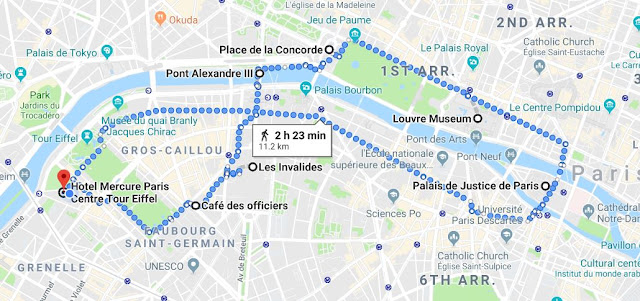Monday on our own
After a late start at noon and a stop for coffee and crepes we were ready to go.
A rough map of our sojourn, it doesn't include our meanderings into the Latin Quarter and other such stops. I've left out some churches and murals as well.
As we left our hotel.
Les Invalides, formally the Hôtel national des Invalides (The National Residence of the Invalids), or also as Hôtel des Invalides, is a complex of buildings in the 7th arrondissement, containing museums and monuments, all relating to the military history of France, as well as a hospital and a retirement home for war veterans, the building's original purpose.
Not much interested or have enough time we opt to not buy tickets for the museums and just wander the grounds.
At 102 metres long and 64 metres wide, this is the largest courtyard at Les Invalides. An example of 17th-century classical architecture, it is enclosed by four buildings, each of which has two levels of galleries with arcades. The lavish decoration of the dormers is a break from the architectural sobriety of the façades and marks the top part of the building. The martial motifs combining symbolic figures with trophies of arms proclaim the site's military purpose.
These prestigious bronze pieces are all decorated with heraldic and mythological ornamentation. From the wars of Louis XIV to the battles of the Second Empire, they remind visitors of the royal and imperial armies' victories.
The buildings house the Musée de l'Armée, the military museum of the Army of France, the Musée des Plans-Reliefs, and the Musée d'Histoire Contemporaine, as well as the Dôme des Invalides, a large church, the tallest in Paris at a height of 107 meters, with the tombs of some of France's war heroes, most notably Napoleon.
We thought we;d go visit The Thinker at the Rodin, but it's closed on Mondays.
Crossing the Pont Alexandre III in much nicer weather.
The Fontaines de la Concorde are two monumental fountains located in the Place de la Concorde. They were designed by Jacques Ignace Hittorff, and completed in 1840 during the reign of King Louis-Philippe. The south fountain commemorates the maritime commerce and industry of France, and the north fountain commemorates navigation and commerce on the rivers of France.
In the decades following the chaos of the French Revolution, the square acquired its current appearance between 1836 and 1840, when the imposing 3,300-year-old Egyptian obelisk was placed in its center, by orders of King Louis Philippe, in 1836. The obelisk was a gift sent from the Egyptian government to France in 1829. Decorated with hieroglyphics that allude to the reign of pharaoh, Ramesses II, the obelisk had once marked the entrance to the Luxor Temple. In order to immortalize the intrepid and complicated task of transporting the obelisk – due to the technical limitations back in the day – on the pedestal are carved diagrams explaining the machinery that had to be used for the transportation from Egypt to France. Since the obelisk was missing its original cap – believed to be stolen in the 6th century BC – the French government added a gold pyramid cap to the top of the obelisk in 1998.
A view of the Arch de Triomphe down the Champs Élysées.
Intertwined hands laid on five granite stones, varying in size from 20 to 30 inches wide and high… These hands tell so much. Who do they belong to? Why are they cut off?
These hands hold each other, tightly. They intertwine and hold on to each other as to prevent the other one to leave.
This work, titled The Welcoming Hands, is another demonstration of Louise Bourgeois’s genius.
La Foule (The Crowd) is by British artist Raymond Mason.
One of the most notable features was a large garden designed in a Tuscan style which was the home land of Catherine de Midici.
Attracted by the gold sculpture and these blue winged cherubs we end up on Rue Rivoli.
By fluke we turn into a shopping centre that connects the Louvre. We go down, down on escalators and run into the line up for the museum.
We are then in front of the Louvre Pyramide Inversée (Inverted Pyramid) is a skylight constructed in the Carrousel du Louvre, an underground shopping mall in front of the Louvre Museum. It may be thought of as a smaller sibling of the more famous Louvre Pyramid proper, yet turned upside down: its upturned base is easily seen from outside.
It turns out we didn't miss this by our detour.
The Arc de Triomphe du Carrousel is the smallest of the three arches on the Triumphal Way, the central axis between the Louvre and La Défense. The arch is crowned with a bronze chariot.
The Louvre, we've been in it before.
John dubbed this "Harry Potter's". It is the second most obvious landmark on the Ile de la Cité, is the Palais de Justice, essentially the modern Supreme Court built in the 18th century. The earliest seat of government from Roman times was in the same place, as was the original Palace from the Gothic period. The remains are to be found in the St. Chapelle Church and the Conciergerie.
But enough architecture, time for a glass of wine and a plate of cheese as we people watch. That is Notre Dame in the middle of this photo.
Across the bridge.
We were back in the Latin Quarter.
Amazing sunlight as we walked back to near our hotel for dinner.
Les Invalides, once again.
Steps 24,973 18.8 km 11.7 miles
Links to previous posts about this trip:
April 27-28 Toronto to Paris
April 29 Paris
Love Locks
Russian Orthodox Holy Trinity Cathedral














































































